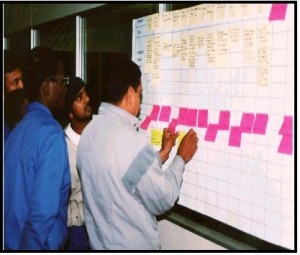Tag Archives: lean
5S Workplace Organisation
 Busy with fixing, painting and reinstalling machine guards as part of their 5S program.
Busy with fixing, painting and reinstalling machine guards as part of their 5S program.
Think backwards to create innovations you can sell!
 Everyone talks about using INNOVATION to improve companies, products, and services to create a competitive advantage. But how do you innovate knowing that the end result is something your customer will value and is willing to pay more for?
Everyone talks about using INNOVATION to improve companies, products, and services to create a competitive advantage. But how do you innovate knowing that the end result is something your customer will value and is willing to pay more for?
Well the first obvious questions are what does your customer value and how do you innovate value? Many customers cannot find a product or service that meets 100% of their needs so they either develop their own solution or focus on ‘the closest fit’- a suite of products or services that best do the job. Their goal is to find a solution that is cost effective and hassle free.
So how do you find the perfect solution for your customers that offers them better innovative value? The answer is ‘think backwards’…look at your business or product service offer (PSO) from your customers point of view. It will both help you understand your customer better and drive customer centric thinking…the first step to creating a competitive advantage.
Value Innovation is the simultaneous pursuit of differentiation and low cost. There are two LEAN tools that when combined offer a great practical way to focus on developing your VALUE INNOVATION skills. They will also help you to create a new value curve, which not only creates differentiation but also new markets.
The first tool is Value Stream Mapping (VSM), which is designed to look at your business processes, from manufacturing to delivery, as a system and focus on creating flow by reducing waste. Remember that each step in the process has an impact on the other steps and the whole business process.
The second tool is Blue Ocean thinking (Kim & Mauborgne), which has a set of tools to interrogate value stream elements. These tools used with questioning techniques such as brainstorming and 5 Why’s drive innovative thinking.
The7 steps to create VALUE INNOVATION are:
- Create an INNOVATION team made up of a representative/s from manufacturing, distribution, administration and sales. Each team member should be chosen by the value they can add to the team. Each team member will be influenced by their own specific business environment and so create diversity when identifying and eliminating waste or interrogating elements.
- Invite one customer to each INNOVATION team meeting. This will allow them to get involved in designing a product or service that will add greater value to their business and reduce the ‘purchase hassle’. It will also add the consumer view point.
- Innovation teams must meet for 1 hour per week to discuss progress and improvement ideas.
- Draw up a flow diagram showing the process starting from when your customer receives the product or service and working backwards. The most effective method is to use post-it’s on a wall chart. Each post-it represents a step in the process and can be moved or eliminated as the new map takes shape. A powerful customer centric tool for creating and reviewing a flow diagram is the Blue Ocean Strategy Canvas. http://homebrewacademy.com/wp-content/uploads/yellow-tail-strategy.png
- Interrogate each of your products, services and business process steps using the Blue Ocean 4 Action Framework.
- ELIMINATE elements that are taken for granted and add no value.
- REDUCE elements that are higher than industry standards and/or exceed customer expectations.
- RAISE elements that are below industry standards and/or do not meet customer expectations.
- CREATE elements that the industry has never offered and/or is on a customer’s ‘wish list’. These elements must add value for the customer.
- Draw up an action list showing changes, actions required, person responsible and time lines. All goals set must be SMART and progress measured weekly.
- Once the new process is complete make sure it becomes the new best operating practice.
Remember INNOVATION is a process of continuous improvement. Good hunting.
Create Enquiring Minds
 The tools for developing the thinking skills of your employees will be under your nose, at your fingertips, or even hanging on your wall. You can begin to build or improve employee thinking skills and job performance with little or no cost to your business. Generally factories have a wealth of charts, pictures, graphs, processes etc. on the walls but most employees mumble when asked what these visuals are. Employees have little say on what information is displayed so no feeling of ownership and little interest. Here a team is busy creating a map to help them visually display the process they follow during a product change on their line. They used it to come up with ideas to improve a changeover process resulting in a reduced in time (56%) and reduction of start-up waste of 73%.
The tools for developing the thinking skills of your employees will be under your nose, at your fingertips, or even hanging on your wall. You can begin to build or improve employee thinking skills and job performance with little or no cost to your business. Generally factories have a wealth of charts, pictures, graphs, processes etc. on the walls but most employees mumble when asked what these visuals are. Employees have little say on what information is displayed so no feeling of ownership and little interest. Here a team is busy creating a map to help them visually display the process they follow during a product change on their line. They used it to come up with ideas to improve a changeover process resulting in a reduced in time (56%) and reduction of start-up waste of 73%.
A number of people responded to our last newsletter asking for more information about using the brainpower of your teams to solve problems. It’s easy to talk about getting teams to think but how is it done in practice. First you must realise that you are trying to change a culture and that is going to take time. There is no quick fix. Some hints on how to simplify the process are…
- Make thinking visible.
- Encourage team members to write down or draw their improvement ideas or problems. It may help to have a standard idea form and problem form.
- Use photo’s – remember a picture says a thousand words. Use arrows and captions to explain the photo.
- Use notice boards to display the ideas and problems. The more people who see the notice board the better.
- Allow everyone to write their comments on the ideas displayed this way you can brainstorm over shifts.
- Reward or recognise ideas that deliver sustainable results or financial benefits.
- Challenge the team. Get them to solve specific problems starting with relatively simple ones progressing in difficulty.
- Teach teams simple problem solving tools
- Make a habit of asking questions. (5 Why analysis)
- Use a Matrix – not only is it good for gathering and sorting information but it also inspires creative thinking and problem solving.
- Involve the team in practically testing and communicating their ideas.
Given the chance people naturally try to improve their lives and make their work easier. All your teams need are the tools to help them improve and lots of support. The results will be amazing and sustainable.
